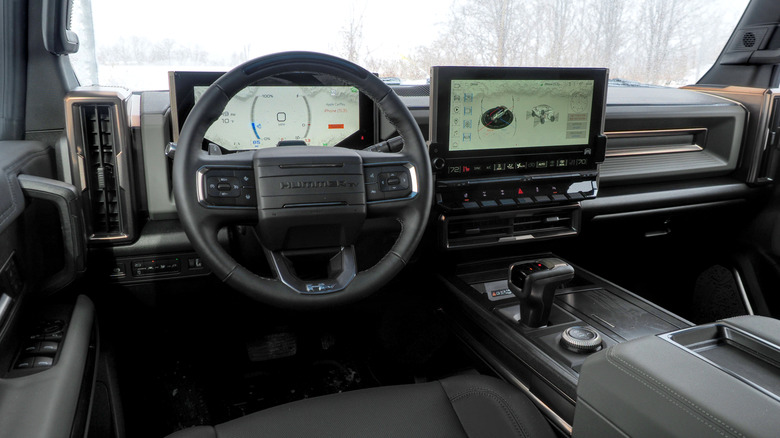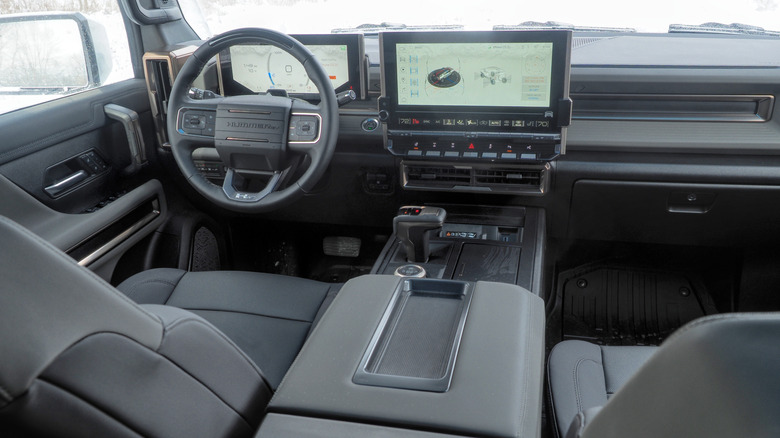How Bad Is The New Hummer EV SUV? It's Complicated
"At least it's not a Cybertruck" is probably not the glowing endorsement you hope for when showing off your new six-figure electric truck, but the GMC Hummer EV SUV is unexpectedly immune to scorn. Once held up as the pinnacle of General Motors' Ultium folly, everything here is large, including the amusement which many bystanders will express as you trundle past. Consider me as surprised as you are, then, that I spent my time with it smiling so darn much.
This flagship 2025 Hummer EV 3X SUV starts at $104,650. That gets you three electric motors — one at the front, and two at the rear — driving 22-inch wheels shod in huge 35-inch all-terrain rubber, and 830 horsepower. The $9,995 Extreme Off-Road Package swaps the wheels for 18-inch versions with mud terrain tires, adds locking front and rear differentials, and a bunch of other tweaks. Adding removable roof panels ($1,495), the charge cord ($350), and destination ($2,295) leaves you at $118,785.
In addition to the big price tag it is, very obviously, a big EV. A huge one, in fact. Seventeen and a quarter feet in length; only about a foot narrower than a Smart Car was long. Sure, you can fold the side mirrors in, and bring that down to a mere 87.5 inches across, but that's still more than an imperious Rolls-Royce Cullinan (an SUV nobody has accused of lacking presence) with its mirrors at full stretch.
Bigger isn't always better
Weirdly, though, it neither looks that vast, nor feels so much so from behind the wheel, as I expected. The proportions — that high waistline and narrow glass, plus the stubby rear compared to the Hummer EV pickup — lend it a toy truck aspect. The sort of chunky little plaything you might've trundled across the rug when you were a kid.
Only really standing in front, and seeing the width of the illuminated grille, makes it clear what a whale this is. Well, that and charging it. Boasting around 170 kWh of capacity, the 20-module Ultium battery pack is literally twice the size of what most EVs carry, all to ensure the Hummer EV SUV's hardly-standout 289 mile range rating.
Theoretically, GM claims "up to nearly 30 miles" of range added per hour plugged into a Level 2 (i.e. home) charger. That's assuming you're the rare person who has a 19.2 kW/80A charger at home. Without that, my more pedestrian Level 2 charger only saw a fraction of that range restored after hours plugged in.
Speed for the brave
The huge battery contributes significantly to the huge curb weight. GMC declines to say just how much that is, though given the pickup is "approximately 9,000 pounds" somewhere in that ballpark seems likely for the SUV. You sense that heft, as much as the vast width of the truncated hood, when you're driving. Sure, the Hummer EV SUV can be fast, but it wasn't just the snow and ice punctuating my time with this loaner car that held me back most often.
Instead, there's the same sort of restraint which stops you from, say, tipping a three-door wardrobe over at the top of a hill, clambering inside it, and having a strong friend shove you down. Certainly there's fun to be had initially, but lacking confidence in what happens when you run out of hill is a powerful moderating influence. Even with decent-sized mirrors (including the rear-view camera mirror which works around the woefully truncated rear glass, but which still swallowed a following car in the Hummer's blind spot) and slab-sided proportions, there's an animal sense of momentum and physics from deep in your bones.
The irony is that it can be a fairly nimble car, courtesy of rear-wheel steering and a hefty degree of boost to the power steering. Crab Walk remains a gimmick, though, albeit a fun one. Having to hold down the button for several long seconds to activate it will leave disgruntled motorists honking at you, wondering why you're not pulling out of the parking spot they covet.
The Hummer EV is ridiculous, so why do I like it so much?
Too big, then; too powerful for its own good; too hamstrung by GMC's excesses. Rationally, I know I should concur with everyone else who thinks the Hummer EV SUV is a generally ridiculous conceit by General Motors. A ham-fisted attempt to convince the electric-skeptical that "Nah, really, EVs can be just as butch as a gas truck, bro."
Problem is, I can't say I hate it. Maybe it's that toy-like nature, sparking some odd nostalgia in my middle-aged brain, or just the fact that GMC leans so heavily into the schtick. Perhaps the fun of driving something so large, yet so quiet, feels so strange as to be entertaining. For the duration of a week-long loan, at least.
It is an indulgent, profligate thing. Outsized, yet barely taking advantage of that with its interior dimensions. Lavished with so many LEDs, so much knurled switchgear, all the signifiers of burly toughness; it's only when you get close that the effect struggles, when you realize how much is plastic and posturing. The Hummer EV SUV is to its military inspirations, as the Cinderella Castle at Disney World is to Neuschwanstein and Hohenzollern.
Maybe it's time to cut EVs a little slack
The thought I keep coming back to, though, is that we do EVs a disservice by expecting them to always be all things, to all drivers. We saw that when the first examples began slipping into automakers' line-ups: if they couldn't drive as fast, and as far, and as luxuriously, and with the same practicality as every internal combustion vehicle spread around them in the showroom, they were inevitably deemed failures.
Even as the options in the EV market have increased, the benchmarks remain weirdly — you might say unfairly — high. Doomed, if they don't deliver range to suit the outliers of the impulsive road-tripper; pointless, if they prioritize anything other than absolute frugality and practicality (but they still have to be supercar fast).
There are legitimate questions to be asked of the Hummer EV series, certainly. A vehicle that demands the battery resources of two smaller, lighter, cheaper cars seems excessive. Like all vast trucks, pedestrian safety feels like an afterthought. The dashboard interface — with its Unreal-powered graphics struggling to keep up with what the buttons and knobs are doing — is overwrought to the point of confusing. Who, honestly, is asking for all this?
If gas cars can be niche, why not EVs?
Yet I'm not quite ready to insist that the newest Hummer's existence is some assault on the good name of electrification. In 2024, for instance, GMC sold just shy of 14,000 of the Hummer EV in both SUV and pickup flavors. That's nearly 20,000 less than stablemate Chevy sold Corvettes in the same twelve months. Porsche shifted more of the 911 in the U.S. in 2024 – at 14,128 units – than GMC did of its electric monster truck.
Nobody looks at the 'Vette, or the 911, and says, "Yeah, but where do my three kids and two large dogs sit?" Or, if they do, we don't take those complaints seriously, because there's an acknowledgment, broadly, that cars are allowed to be fun. Niches exist; specialist models satisfy a subsection of a subsection of drivers — assuming they have the budget for them — and they work because they're a fraction of a percentage of overall vehicle sales.
A six-figure sanity check
For all I found the Hummer EV SUV charming, though, I can't in good conscience recommend you actually buy one yourself. A Rivian R1S is half a foot shorter, but has seating for seven. In Tri-Motor form it'll do 0-60 in 2.9 seconds — the upcoming Quad-Motor version trims that to 2.5 seconds — for almost exactly the same price as the GMC, but Rivian's interior feels far more luxurious, and it has more range.
Or, there's the fast approaching — meant literally — Lucid Gravity. Another three-row option, with a starting price just shy of six figures, all signs point to not just straight level speed but astonishing performance in the corners. Plus a cabin to match the luxe positioning.
Even determined electric off-road enthusiasts have better options out there. Mercedes' G 580 with EQ Technology — aka the electric G-Wagen — is more expensive, from $161,500, but it's also more prestigious and has genuine wilderness credibility. Not least the fact that the body wrapping its four individual electric motors (one for each wheel) is almost a foot narrower than that of the Hummer EV SUV. There'll literally be places you can go in the 'Benz that you can't in the GMC, simply because it doesn't fit.
It's probably not for you, and that's okay
In the end, if General Motors only planned to make one electric car and that happened to be the Hummer EV SUV, I'd probably feel a lot less charitable. You could certainly make the argument that at least some of the early ire the original pickup version faced was due to it arriving well in advance of cheaper, more mass-market-appropriate Ultium EVs.
In the intervening years, we've seen not one but two well-received and relatively affordable electric SUVs on the same platform. The Equinox EV and Blazer EV don't side-scuttle like crabs, and nor will they rival sports cars with their 0-60 times. Nonetheless, in 2024 Chevrolet sold close to four times as many of them when compared to the Hummer EV.
That's as it should be, I think. Meanwhile, GMC's beefy boy wouldn't be my first pick for six-figure electric excess — just like a Corvette ZR1 wouldn't be my first choice if I was spending around $200,000 on a sports car — but you may very well feel differently, and that's just swell. "You pays your money and you takes your choice," as the old proverb goes. The Hummer EV SUV is silly, and definitely not for everyone, but I'm oddly pleased that it exists at all.













